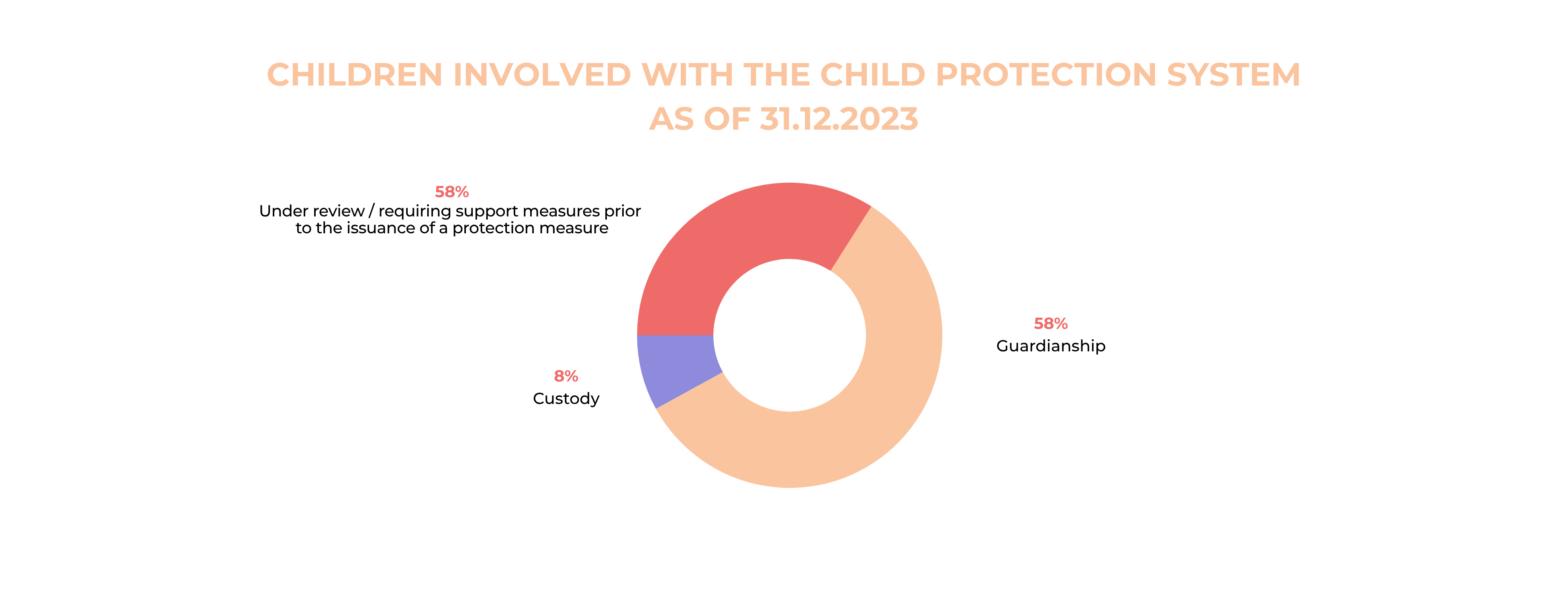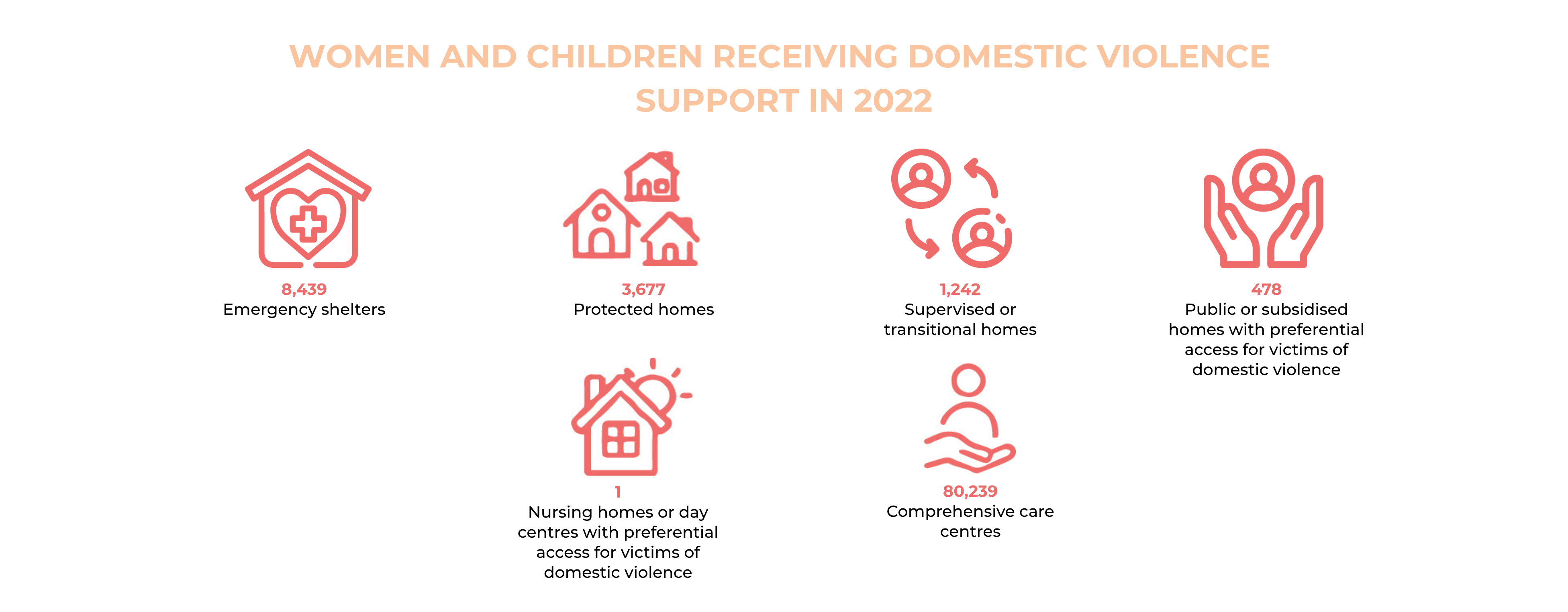Recommendation
Spain should strengthen resources, streamline implementation, and sustainably increase public funding for its System for Long-term Care and Autonomy. The goal should be to move towards a long-term care system that guarantees equal access to services throughout the country and promotes personalised support, proximity, autonomy, and independent living.
Social Services Legislation
Right to access social services
✅ Article 148.1.20ª of the Spanish Constitution states that the regions are responsible for social assistance. All regions have approved their own social services laws, which regulate citizens’ rights according to their place of residence, including guiding principles, benefits, and services.
Definition of social services
✅ Each regional law on social services defines social services.
In 2023, the Council of Ministers approved a draft law on basic conditions for equality in access to and enjoyment of social services, providing a definition of social services at national level. However, this law has not been brought to parliament.
Representatives of the social work profession have put forward a Public Social Services System Model grounded in Social Work, which includes a definition of social services.
National social services catalogue
✅ The Social Services Reference Catalogue lists the social services and benefits that people may access throughout the country. The services are grouped in seven thematic areas:
- Information, guidance, counselling, and assessment.
- Personal autonomy, home care, and family respite.
- Family support.
- Child protection.
- Residential care.
- Prevention and social inclusion.
- Legal protection.
Benefits include minimum income support, assistance for victims of gender-based violence and people with long-term care needs, and other financial benefits.
National social services strategic plan
✅ The Concerted Plan of Basic Social Services Benefits, developed through cooperation between the state, regional, and local authorities and approved in 1988, explains the responsibilities of local authorities regarding public social services. The General State Budget determines the annual budget for this plan. In 2024, the Family Protection and Child Poverty Relief Programme – Basic Social Services Benefits managed €198,704,000, which included the financing of three social programmes aimed at protecting the family and addressing child poverty, reinforcing child and family care teams in primary care social services, and supporting basic social services benefits (including the Concerted Plan).
There are also specific national plans and strategies, such as the Strategic Plan for the Network of IMSERSO Centres, which promotes innovation in social programmes for people with disabilities and older people within the framework of Law 39 of 14 December 2006 on the promotion of personal autonomy and care for dependent persons.
Responsibilities of national, regional, and local authorities
At the national level, the government is mostly responsible for the coordination of social services. The authority responsible is the Ministry of Social Rights, Consumer Affairs and 2030 Agenda, specifically the State Secretariat for Social Rights, which is subdivided into general directorates such as the Institute for Older People and Social Services (IMSERSO) and the General Directorate of Family Diversity and Social Services.
The management of social services is then decentralised to the autonomous communities or regions (comunidades autónomas), which are also responsible for drafting their own legislation. Public authorities can then decide to contract out social service provision to non-profit associations, foundations, and companies.
The financing of social services is shared between the national government and regional governments.
Social Services Expenditure
As of 1 January 2024, Spain’s population was 48,619,695 people (Source: Eurostat). That same year, the country’s gross domestic product (at market prices) reached €1,591,627.0 million (Source: Eurostat).
In 2022, the Concerted Plan of Basic Social Services Benefits, amounting to €2,560,829,524.02, was financed by:
- Ministry of Social Rights, Consumer Affairs, and 2030 Agenda: 4.23%.
- Autonomous Communities and Cities: 55.14%.
- Local enterprises: 40.47%.
- Surplus: 0.16% (Source: Ministry of Social Rights, Consumer Affairs, and 2030 Agenda)
In Spain, social protection spending includes, among others, pensions, unemployment benefits, and active employment policies (including training). In 2023, 40.69% of the total public spending was for social protection. At the national level, except for the Concerted Plan, there is no specific spending on social services (Source: INE).
The 2024 General State Budget allocated the following amounts to these ministries:
- Ministry of Social Rights, Consumer Affairs, and 2030 Agenda: €493,759.59 (budget for other social services of the state, assistance for children and families, and the General Directorate and Services of Social Rights and 2030 Agenda).
- Ministry of Housing and Urban Agenda: €959,516.75.
- Ministry of Youth and Children: €41,437.86.
- Ministry of Inclusion, Social Security and Migration: €67,098.63.
Social Services Coverage
Social Services Workforce
As of 1 June 2024, 51,768 social workers were registered with Spain’s professional association of social workers (Source: General Council of Social Work).
The social services workforce consists of professionals such as social workers, social educators, psychologists, caregivers, home care assistants, lawyers, etc. In the fourth quarter of 2024, the number of workers affiliated with the social services sector reached 756,510 (Source: IMSERSO).
Long-term Care Services for Older People
Population aged 65+
As of 1 January 2024, 20.4% of the population or 9,928,368 people were aged 65 and over (Source: Eurostat).
As of 31 December 2024, the population of older people with long-term care needs was estimated at 6,326,950, of whom only 34.23% were registered to receive care and support. Of those who registered (2,165,648), 1,604,231 people were over the age of 65.
The following number of people aged 65+ were assessed as having a degree of dependency as follows:
- Moderate (grade I): 438,797.
- Significant (grade II): 445,855.
- Severe (grade III): 318,873.
The average waiting time from the moment an application for long-term care is submitted to the assessment being finalised is 212 days, while the average waiting time from assessment to service provision is 90 days. The overall waiting time for the whole process is 340 days.
1,518,424 people, of whom 1,112,848 were aged 65+, had an individual care plan (Programa Individual de Atención – PIA) (Source: IMSERSO).
Residential care facilities, day care centres, home care services, personal assistants, and telecare services
In 2022, there were 381,514 places available across 5,188 residential care centres for older people.
Of the 4,396 centres, with 323,272 places, which provided information to IMSERSO:
- 386 were publicly owned but managed by the for-profit private sector (24,905 places):
- 144 were publicly owned but managed by the non-profit private sector (8,360 places).
- 623 were owned and managed by the public sector (45,867 places).
- 2,134 were owned and managed by the for-profit private sector (160,180 places).
- 1,109 were owned and managed by the non-profit private sector (83,960 places).
In 2022, 288,765 older people lived in residential care centres:
- 283,091 on a permanent basis.
- 5,674 on a temporary basis (Source: IMSERSO).
As of 31 December 2022, there were 105,447 places across 3,545 day care centres for older people, of which:
- 1,517 were public (67,536 places).
- 2,028 were private (37,911 places).
In total, 66,421 older people accessed day care (Source: IMSERSO).
As of 31 December 2024, the following number of services were provided to people of all ages with long-term care needs:
- Prevention of dependency and promotion of personal autonomy: 78,342.
- Home care: 357,497.
- Telecare: 524,561.
- Day or night care: 110,349.
- Residential care: 184,545.
- Financial allowance to contract care services: 222,787.
- Financial allowance to support care by the family: 636,030.
- Personal assistance: 11,034.
It is not possible to identify how many of these services were provided to people aged 65+.
The number of hours of home care granted depends on the degree of dependency. The average number of home care hours per month, as of 31 December 2024, was:
- Moderate (grade I): 18.3.
- Significant (grade II): 40.4.
- Severe (grade III): 61.6 (Source: IMSERSO).
Strategies
The National Strategy for a New Model of Care in the Community 2024-2030 aims to ensure that older adults and people with disabilities can receive support and care in their homes and communities, advancing deinstitutionalisation and a more dignified, inclusive, and personalised model.
Long-term Care Services for Adults with Disabilities
Population aged 18+ with disabilities
As of 31 December 2023, 3,361,444 people had a recognised disability (of 33% or more). Of these, 3,158,360 were aged 18+ (Source: IMSERSO).
In 2023, 378,011 people of all ages resided in centres for older people, centres for people with disabilities, psychiatric and geriatric hospitals, and sheltered housing. Of these, 357,894 people (94.7%) claimed to have a disability. The most frequent disabilities were related to basic activities of daily living:
- 88.6% had difficulties with their own care.
- 86.9% had difficulties with domestic life.
- 86.2% had significant mobility difficulties (Source: INE).
Residential care facilities, day care centres, home care services, personal assistants, and telecare services
In 2022, there were 1,455 residential care centres for people with disabilities.
Of the 1,187 centres, with 35,923 places, which provided information to IMSERSO:
- 28 were publicly owned but managed by the for-profit private sector (1,086 places):
- 62 were publicly owned but managed by the non-profit private sector (2,179 places).
- 163 were owned and managed by the public sector (7,085 places).
- 68 were owned and managed by the for-profit private sector (3,370 places).
- 866 were owned and managed by the non-profit private sector (22,203 places).
In 2022, 32,934 people with disabilities lived in residential care centres:
- 32,093 on a permanent basis.
- 841 on a temporary basis (Source: IMSERSO).
As of 31 December 2024, the following number of services were provided to people of all ages with long-term care needs:
- Prevention of dependency and promotion of personal autonomy: 78,342.
- Home care: 357,497.
- Telecare: 524,561.
- Day or night care: 110,349.
- Residential care: 184,545.
- Financial allowance to contract care services: 222,787.
- Financial allowance to support care by the family: 636,030.
- Personal assistance: 11,034.
It is not possible to identify how many of these services were provided to people aged 65+.
The number of hours of home care granted depends on the degree of dependency. The average number of home care hours per month, as of 31 December 2024, was:
- Moderate (grade I): 18.3.
- Significant (grade II): 40.4.
- Severe (grade III): 61.6 (Source: IMSERSO).
Child Protection
As of 31 December 2023, 51,972 children were involved with the public child protection system, including:
- Under review / requiring support measures prior to the issuance of a protection measure: 17,827.
- Guardianship (tutela ex lege): 30,074.
- Custody (guarda): 4,071, of whom:
- Voluntary: 1,559.
- Judicial, without declaration of abandonment: 48.
- Provisional (immediate attention): 2,464.
At that same time, 35,209 children were placed in alternative care. Of these:
- 18,097 were in foster care.
- 17,112 were in residential care (Source: Ministry of Youth and Childhood).

Domestic Violence Support Services
Women experiencing domestic violence
In 2024, 48 women were murdered due to gender-based violence.
As of December 2024, 101,962 active cases were recorded by the Spanish monitoring system for gender-based violence (Sistema de Seguimiento Integral en los casos de Violencia de Género – VioGén) (Source: Ministry of Equality).
Women receiving support from domestic violence support services
In 2024, the Spanish information and legal counselling service on gender-based violence against women (Servicio de Información y Asesoramiento Jurídico en Materia de Violencia Contra las Mujeres por Razón de Género) received 8,361 relevant calls.
As of 31 December 2024, the following data was recorded:
- 19,495 active users with the Spanish hotline for victims of gender-based violence (Servicio Telefónico de Atención y Protección para Víctimas de Violencia de Género – ATENPRO).
- 4,595 active devices for measuring distance in cases of gender-based violence (Sistema de Seguimiento por Medios Telemáticos de las Medidas de Alejamiento en el Ámbito de la Violencia de Género).
- 58,367 women under police protection (Source: Ministry of Equality).
Emergency accommodation centres
In 2022, there were:
- 56 emergency shelters (847 places), supporting 8,439 women and children.
- 117 protected homes (1,810 places), supporting 3,677 women and children.
- 134 supervised or transitional homes (1,153 places), supporting 1,242 women and children.
- 9,354 public or subsidised homes with preferential access for victims of domestic violence, supporting 478 women.
- 89 nursing homes or day centres with preferential access for victims of domestic violence, supporting 14 women.
- 475 comprehensive care centres, supporting 80,239 women and children (Source: Ministry of Equality).

Reforms
The Royal Decree 664 of 9 July 2024 established a regulatory framework for granting financial aid to victims of sexual violence, improving their protection and support.
In February 2025, a new State Pact against Gender-based Violence was approved, expanding the pact signed in 2017 and covering all forms of violence against women, including economic, digital, and vicarious violence.
Minimum Income Schemes
The minimum income support (Renta Mínimas de Inserción – RMI) is intended for individuals and families who lack sufficient economic resources to cover their basic needs, accompanied by social interventions and sometimes job placements. Regions and large cities are responsible for managing this benefit.
The minimum living income (Ingreso Mínimo Vital – IMV) is a financial benefit intended to cover basic needs and prevent poverty and social exclusion. It can be combined with the child support supplement (Complemento de ayuda a la infancia).
In 2023, 571,732 people benefited from minimum income support. Of these:
- 258,568 were direct beneficiaries.
- 313,164 were dependents (Source: Ministry of Social Rights, Consumer Affairs and 2030 Agenda).
In April 2025, 719,543 households received the minimum living income, benefiting 2,194,586 people. Of these, 41.3% were children and adolescents (905,371) (Source: Seguridad Social).
Reforms
On 27 September 2022, Spain introduced a work incentive (incentive al empleo) to encourage beneficiaries of the minimum living income to increase their participation in the labour market. This incentive, designed to guarantee that income increases with working hours, is granted in the first year of increased employment (Source: OECD).
Housing and Homelessness Support
Housing support allowances
The State Plan for Access to Housing 2022-2025 foresees various programmes to ensure access to decent housing for, among others, victims of gender-based violence, people evicted from their usual home, homeless people, young people, and other vulnerable people.
Homeless people
In 2022, 28,552 people were supported in shelters and assistance centres, the majority of whom were men (76.7%). Of these:
- 7,277 lived on the streets.
- 11,498 lived in shelters and reception centres.
- 9,778 lived in flats and guesthouses (Source: INE).
In 2022, 1,175 centres were available to support homeless people.
As of 15 December 2022, there were 28,026 places in accommodation centres for adults. Of these, 22,310 were occupied (Source: INE).
Strategies
The National Strategy to Combat Homelessness 2023-2030 aims to reduce the number of people who are involuntarily homeless in Spain by 95% by 2030.

